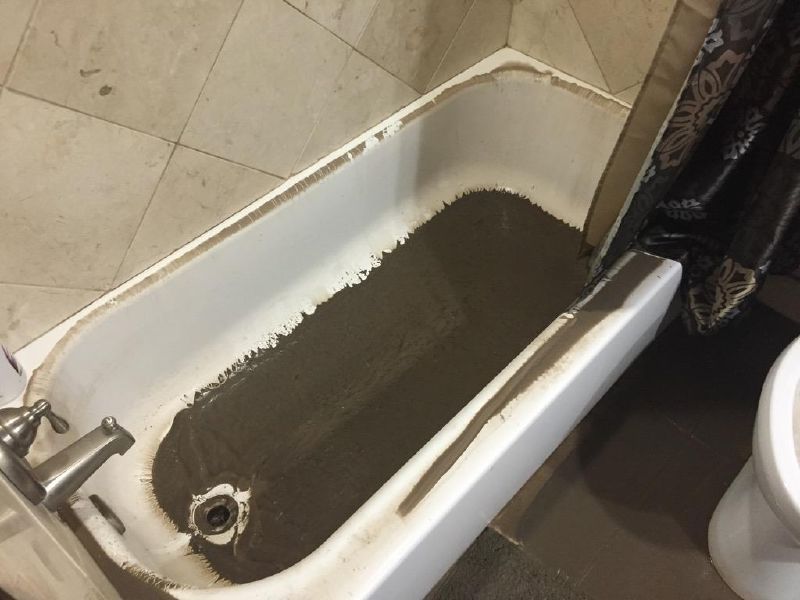Unraveling the Causes of Sewage in the Bathtub
Unraveling the Causes of Sewage in the Bathtub
Blog Article
What are your opinions on What to Do if Sewage Starts Coming Up Through Your Bathtub?

Sewage back-up in the bathtub can be a stressful and unsanitary problem for any type of home owner. Not just is it bothersome, yet it likewise presents major health and wellness risks and suggests underlying issues with the plumbing system. Understanding why sewage is turning up with the bathtub is essential for taking ideal action to address the issue effectively.
Intro to the Issue
Comprehending the Trouble
When sewage draws back up right into the bathtub, it's a clear indicator of a trouble with the drainage system. The wastewater that must be moving away from your home is instead discovering its back right into your space, which can lead to significant damage and health hazards.
Prospective Reasons
A number of aspects can contribute to sewage backup in the bath tub. From clogs in the drain line to concerns with the plumbing facilities, identifying the root cause is crucial for discovering an option.
Common Factors for Sewage Back-up
Clogs in the Drain Line
One of the most common reasons for sewer back-up is a blockage in the sewage system line. This can occur due to the accumulation of particles, grease, or foreign objects in the pipes, stopping appropriate flow and creating sewer to back up right into your tub.
Tree Origin Intrusion
Tree origins seeking dampness and nutrients can infiltrate drain lines through tiny cracks or joints. Gradually, these origins can expand and increase, causing considerable damage to the pipes and bring about sewage back-up concerns.
Aging Infrastructure
Older homes may have outdated plumbing systems that are much more prone to rust, splits, and wear and tear. As pipes age, they become more prone to leakages and clogs, increasing the chance of sewer back-up incidents.
Heavy Rainfall or Flooding
Throughout durations of heavy rainfall or flooding, the sewer system may become overloaded with excess water, triggering backups and overflows. This can result in sewer supporting right into tubs and other fixtures inside the home.
Health Dangers Connected With Sewage Back-up
Contamination of Supply Of Water
Sewage backup can infect the supply of water in your house, posturing a serious health and wellness threat to you and your family. Exposure to infected water can bring about intestinal problems, skin infections, and various other diseases.
Spread of Disease
Sewer contains harmful germs, viruses, and bloodsuckers that can cause a series of illness, including hepatitis, cholera, and gastroenteritis. Entering contact with sewage or polluted surfaces puts you at risk of infection.
Mold and mildew Development
Wetness from sewer back-up can produce optimal conditions for mold growth in your home. Mold spores can intensify breathing problems and cause allergic reactions in delicate individuals, making timely cleaning important.
Signs of Sewer Backup
Foul Odors
Undesirable smells emanating from drains pipes or fixtures, particularly in the shower room, may show sewer backup concerns. These smells are usually solid and persistent, signaling a trouble that requires instant attention.
Slow Draining Fixtures
Bathtubs, sinks, and toilets that drain pipes slowly or not at all could be experiencing sewage backup. If several components are affected at the same time, it's most likely that the concern stems from a common factor, such as the primary sewage system line.
Gurgling Sounds
Weird gurgling or bubbling noises coming from drains pipes when water is running elsewhere in your home are a sign of air trapped in the plumbing system. This air buildup can result from sewage backup and ought to be explored immediately.
Immediate Actions to Take
Shutting Off Supply Of Water
In the event of sewer back-up, it's vital to switch off the water system to stop further contamination and damage. Situate the primary water shutoff valve in your home and closed it off until the problem can be fixed.
Getting In Touch With a Specialist Plumber
Handling sewer backup is not a do it yourself job. Call a certified plumber with experience in taking care of sewage-related problems to analyze the situation and execute essential fixings or cleanings.
Preventing Contact with Infected Water
Up until the sewage back-up is settled, stay clear of contact with polluted water to stop the spread of germs and pathogens. Use protective gear if you have to be in the damaged area and clean your hands thoroughly afterward.
Safety nets
Normal Upkeep of Sewer Lines
Arrange regular inspections and maintenance of your sewage system lines to identify and resolve potential problems before they rise into major problems. This can include clearing out particles, evaluating for tree origin breach, and fixing any damaged pipes.
Mounting Backwater Shutoffs
Take into consideration setting up backwater shutoffs in your plumbing system to stop sewage from flowing back into your home during durations of heavy rainfall or flooding. These shutoffs instantly close when water draws back up, securing your residential or commercial property from contamination.
Correct Disposal of Family Waste
Avoid purging anything other than bathroom tissue and human waste down the toilet to avoid blockages and clogs in the sewer line. Dispose of grease, oil, and other family chemicals effectively to minimize the danger of plumbing problems.
Tidying up After Sewer Back-up
Sanitation Procedures
Thoroughly disinfect and sanitize affected locations after sewage back-up to remove unsafe germs and avoid mold growth. Use suitable cleaning products and safety gear to guarantee safe and reliable cleaning.
Repair of Affected Locations
Repair any damages to flooring, wall surfaces, or fixtures caused by sewer backup. Depending upon the extent of the damages, you may need to change carpeting, drywall, or various other materials to recover your home to its pre-loss problem.
Why is Sewage Coming Up Through Your Bathtub?
Reasons You May Have Sewage in Your Bathtub
All the drains in your home lead down different pipes to get to the main sewer line. If you’re seeing sewage in the bathtub, the problem is that the main sewer line is clogged up, which is causing the water running through other drains to be pushed back into other pipes. The problem isn’t the bathtub, but the main line. The sewer line can get backed up by anything that goes down the drain, from food waste, hair and soap particles to jewelry or children’s toys. Tree branches or dirt can also impact the sewer line. If you’re seeing sewage in the bathtub, you have a big problem that usually needs a professional plumber. Trying to fix this problem without the right tools or knowledge can lead to bigger plumbing problems.
Fixing a Clogged Sewage Line
Although you shouldn’t try to fix the clogged sewer line on your own, you may be able to mitigate the issue until you can get a plumber to your home. A plunger isn’t going to help, because it won’t be able to reach the sewage drain to unblock the problem.
Turn Off Water
Find the main shutoff valve to your home to turn off the water. This prevents more water from going down the drain which is only going to flow back into your bathtub.
Snake the Toilet and Drain
Start by using a drain pipe snake to clean out the toilet drain. Rotate the snake clockwise when you push the snake down. As you pull it out, the snake should spin counterclockwise. Follow up by snaking out the bathtub drain. If you are successful, both the toilet and shower will drain efficiently. If you’re not successful, you probably have a bigger problem than your tools and experience can manage.
Contact a Professional Plumber
Pros have the tools to find the source of the problem and the experience to manage big blockages without causing more damage to your pipes. It can save you a lot of stress by contacting the professionals sooner rather than later.
Identify the Early Signs of a Clogged Sewage Line
If you’re gearing up for a holiday family gathering or just want to avoid the hassle of a clogged sewage line in your home, make sure you recognize the signs of a clogged sewer line.
Slow drains are a sign of a sewer line problem. Gurgling drains from any drain in your home indicate that you may have an obstruction in the drains. If your toilet keeps getting clogged, it might be a problem with the sewer line. When you see laundry water or water from the dishwasher in different sinks in the home, it’s an indication that your sewer drain is beginning to get backed up. These symptoms can often be “fixed” temporarily to get through a day or week before you start seeing the same problem. When it comes to plumbing problems, you want to fix the root of the problem instead of muddling through. The clog will not go away on its own.
https://handymanconnection.com/mississauga/articles/why-is-sewage-coming-up-through-your-bathtub/

As a keen person who reads on Water Coming up Bathtub Drain, I thought sharing that information was a good idea. Sharing is good. Helping others is fun. Thanks a lot for your time spent reading it.
Recurring Service Plans
Report this page